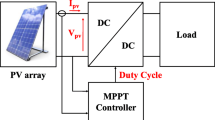Abstract
Due to the economic and technical advantages, the use of solar energy is expanding in developed countries. The extraction of maximum power in solar power plants is an important issue that requires extensive research. Extracting the maximum possible power in solar power plants can increase the efficiency of this type of renewable energy sources (RESs). Climatic condition is a very important feature of solar systems. In fact, radiation and temperature are two important parameters that affect the efficiency of solar systems. This paper suggests a novel maximum power point tracking (MPPT) technique based on the sliding mode controller (SMC) to extract the maximum power of photovoltaic (PV) systems in different climatic circumstances. To obtain the optimal coefficients of the SMC online, the Grey wolf optimizer (GWO) algorithm is employed. SMC coefficients are applied for the variable perturb and observe (P&O) step of MPPT. The proposed GWO-SMC controller can eliminate oscillations in the transient mode and guarantee stability. The findings of the simulation indicate that with the use of an MPPT controller for the solar-PV system, such as P&O, Fuzzy Logic (FLC), Incremental Conductance (INC), the β method, and hill climbing (HC) MPPT, the system will operate more efficiently. The method that has been suggested is tested in a number of different climate conditions. The findings indicate that the proposed technique has an efficiency of 99%, which demonstrates a substantially superior response time when reaching the MPP in comparison to prevalent methods, which have an efficiency of 92 to 97%. The results of the simulations allow for the various approaches to be ranked as follows: 1. GWO-SMC, 2. FLC, 3. INC, 4. β method, 5. P&O, 6. HC with response times of 0.14 s, 0.17 s, 0.23 s, 0.25, 0.28 s and 0.35, respectively. The fluctuations using the combinatorial GWO-SMC technique is 4.31 W, while that of the P&O is 74.56 W. Through simulation and testing with the MATLAB software, the developed method's performance is evaluated to make a comparison.













Similar content being viewed by others
Data availability
Enquiries about data availability should be directed to the authors.
Abbreviations
- MPPT:
-
Maximum power point tracking
- SMC:
-
Sliding mode controller
- PV:
-
Photovoltaic
- GWO:
-
Grey wolf optimizer
- P&O:
-
Perturb and observe
- RES:
-
Renewable energy sources
- INC:
-
Incremental conductance
- HC:
-
Hill-climbing
- FLCs:
-
Fuzzy logic controller
- ANNs:
-
Artificial neural networks
- GA:
-
Genetic algorithm
- PSCs:
-
Partial shading conditions
- PWM:
-
Pulse-width modulation
- T :
-
Temperature
- G :
-
Radiation
- n :
-
Ideality factor
- Eg :
-
Bandgap
- PLL:
-
Phase lock loop
References
Cortajarena JA, Barambones O, Alkorta P, De Marcos J (2017) Sliding mode control of grid-tied single-phase inverter in a photovoltaic MPPT application. Sol Energy 1(155):793–804
Dadfar S, Wakil K, Khaksar M, Rezvani A, Miveh MR, Gandomkar M (2019) Enhanced control strategies for a hybrid battery/photovoltaic system using FGS-PID in grid-connected mode. Int J Hydrogen Energy 44(29):14642–14660
Delavari H, Zolfi M (2021) Maximum power point tracking in photovoltaic systems using indirect adaptive fuzzy robust controller. Soft Comput 15:1–7
Derrac J, García S, Molina D, Herrera F (2011) A practical tutorial on the use of nonparametric statistical tests as a methodology for comparing evolutionary and swarm intelligence algorithms. Swarm Evol Comput 1(1):3–18
El Khazane J, Tissir EH (2018) Achievement of MPPT by finite time convergence sliding mode control for photovoltaic pumping system. Sol Energy 15(166):13–20
Fallahpour A, Nayeri S, Sheikhalishahi M, Wong KY, Tian G, Fathollahi-Fard AM (2021) A hyper-hybrid fuzzy decision-making framework for the sustainable-resilient supplier selection problem: a case study of Malaysian palm oil industry. Environ Sci Pollut Res 28:1–21
Fathollahi-Fard AM, Ahmadi A, Karimi B (2021) Multi-objective optimization of home healthcare with working-time balancing and care continuity. Sustainability 13(22):12431
Fathollahi-Fard AM, Niaz Azari M, Hajiaghaei-Keshteli M (2021) An improved red deer algorithm for addressing a direct current brushless motor design problem. Scientia Iranica 28(3):1750–1764
Ghadami N, Gheibi M, Kian Z, Faramarz MG, Naghedi R, Eftekhari M, Fathollahi-Fard AM, Dulebenets MA, Tian G (2021) Implementation of solar energy in smart cities using an integration of artificial neural network, photovoltaic system and classical Delphi methods. Sustain Cities Soc 1(74):103149
Gheibi M, Eftekhari M, Akrami M, Emrani N, Hajiaghaei-Keshteli M, Fathollahi-Fard AM, Yazdani M (2022) A sustainable decision support system for drinking water systems: resiliency improvement against cyanide contamination. Infrastructures 7(7):88
Gholizadeh H, Fathollahi-Fard AM, Fazlollahtabar H, Charles V (2022) Fuzzy data-driven scenario-based robust data envelopment analysis for prediction and optimisation of an electrical discharge machine’s parameters. Expert Syst Appl 1(193):116419
González-Castaño C, Restrepo C, Kouro S, Rodriguez J (2021) MPPT algorithm based on artificial bee colony for PV system. IEEE Access 17(9):43121–43133
Ishaque K, Salam Z, Amjad M, Mekhilef S (2012) An improved particle swarm optimization (PSO)–based MPPT for PV with reduced steady-state oscillation. IEEE Trans Power Electron 27(8):3627–3638
Javed S, Ishaque K (2022) A comprehensive analyses with new findings of different PSO variants for MPPT problem under partial shading. Ain Shams Eng J 13(5):101680
Ji W, Qiu J, Karimi HR (2019) Fuzzy-model-based output feedback sliding mode control for discrete-time uncertain nonlinear systems. IEEE Trans Fuzzy Syst 28(8):1519–1530
Khan MJ, Mathew L (2021) Artificial neural network-based maximum power point tracking controller for real-time hybrid renewable energy system. Soft Comput 25(8):6557–6575
Li Y, Samad S, Ahmed FW, Abdulkareem SS, Hao S, Rezvani A (2020) Analysis and enhancement of PV efficiency with hybrid MSFLA–FLC MPPT method under different environmental conditions. J Clean Prod 20(271):122195
Mirjalili S, Mirjalili SM, Lewis A (2014) Grey wolf optimizer. Adv Eng Softw 69:46–61
Mohanty S, Subudhi B, Ray PK (2015) A new MPPT design using grey wolf optimization technique for photovoltaic system under partial shading conditions. IEEE Trans Sustain Energy 7(1):181–188
Pasha J, Nwodu AL, Fathollahi-Fard AM, Tian G, Li Z, Wang H, Dulebenets MA (2022) Exact and metaheuristic algorithms for the vehicle routing problem with a factory-in-a-box in multi-objective settings. Adv Eng Inform 1(52):101623
Perruquetti W, Barbot JP (2002) Sliding mode control in engineering. Marcel Dekker, New York
Pouresmaeil H, Faramarz MG, ZamaniKherad M, Gheibi M, Fathollahi-Fard AM, Behzadian K, Tian G (2022) A decision support system for coagulation and flocculation processes using the adaptive neuro-fuzzy inference system. Int J Environ Sci Technol 22:1–2
Rezvani A, Izadbakhsh M, Gandomkar M (2016) Microgrid dynamic responses enhancement using artificial neural network-genetic algorithm for photovoltaic system and fuzzy controller for high wind speeds. Int J Numer Model Electron Netw Devices Fields 29(2):309–332
Seydanlou P, Jolai F, Tavakkoli-Moghaddam R, Fathollahi-Fard AM (2022) A multi-objective optimization framework for a sustainable closed-loop supply chain network in the olive industry: hybrid meta-heuristic alg ‘orithms. Expert Syst Appl 13:117566
Shahsavar MM, Akrami M, Gheibi M, Kavianpour B, Fathollahi-Fard AM, Behzadian K (2021) Constructing a smart framework for supplying the biogas energy in green buildings using an integration of response surface methodology, artificial intelligence and petri net modelling. Energy Convers Manage 15(248):114794
Shengqing L, Fujun L, Jian Z, Wen C, Donghui Z (2020) An improved MPPT control strategy based on incremental conductance method. Soft Comput 24(8):6039–6046
Sheskin DJ (2003) Handbook of parametric and nonparametric statistical procedures. Chapman and Hall/CRC, London
Soufyane Benyoucef A, Chouder A, Kara K, Silvestre S (2015) Artificial bee colony based algorithm for maximum power point tracking (MPPT) for PV systems operating under partial shaded conditions. Appl Soft Comput 32:38–48
Tian G, Zhang C, Fathollahi-Fard AM, Li Z, Zhang C, Jiang Z (2022) An enhanced social engineering optimizer for solving an energy-efficient disassembly line balancing problem based on bucket brigades and cloud theory. IEEE Trans Ind Inform. https://doi.org/10.1109/TII.2022.3193866
Tian G, Fathollahi-Fard AM, Ren Y, Li Z, Jiang X (2022) Multi-objective scheduling of priority-based rescue vehicles to extinguish forest fires using a multi-objective discrete gravitational search algorithm. Inf Sci 1(608):578–596
Torres JZ, Cieslak J, Henry D, Davila J (2019) A sliding mode control in a backstepping setup for rendezvous mission on a circular orbit
Wu D, Nariman GS, Mohammed SQ, Shao Z, Rezvani A, Mohajeryami S (2019) Modeling and simulation of novel dynamic control strategy for PV–wind hybrid power system using FGS−PID and RBFNSM methods. Soft Comput 10:1–23
Yu H, Dai H, Tian G, Wu B, Xie Y, Zhu Y, Zhang T, Fathollahi-Fard AM, He Q, Tang H (2021) Key technology and application analysis of quick coding for recovery of retired energy vehicle battery. Renew Sustain Energy Rev 1(135):110129
Funding
This work was supported by the National Natural Science Foundation of China (No.61862051), the Science and Technology Foundation of Guizhou Province (No.ZK[2022]549, No. [2019]1299), the Top-notch Talent Program of Guizhou province (No.KY[2018]080), the Natural Science Foundation of Education of Guizhou province(No.[2019]203) and the Funds of Qiannan Normal University for Nationalities (No. qnsy2018003, No. qnsy2019rc09, No. qnsy2018JS013, No. qnsyrc201715).
Author information
Authors and Affiliations
Corresponding author
Ethics declarations
Conflict of interest
Authors declares that he has no conflict of interest.
Ethical approval
This article does not contain any studies with animals performed by any of the authors.
Additional information
Publisher's Note
Springer Nature remains neutral with regard to jurisdictional claims in published maps and institutional affiliations.
Appendices
Appendix A
GWO parameters:
Number of search-agents = 100 and maximum number of iteration = 50.
Appendix B
See Table 8.
Rights and permissions
Springer Nature or its licensor (e.g. a society or other partner) holds exclusive rights to this article under a publishing agreement with the author(s) or other rightsholder(s); author self-archiving of the accepted manuscript version of this article is solely governed by the terms of such publishing agreement and applicable law.
About this article
Cite this article
Hai, T., Zain, J.M. & Nakamura, H. Maximum power point tracking technique based on variable step size with sliding mode controller in photovoltaic system. Soft Comput 27, 3829–3845 (2023). https://doi.org/10.1007/s00500-022-07588-6
Accepted:
Published:
Issue Date:
DOI: https://doi.org/10.1007/s00500-022-07588-6




